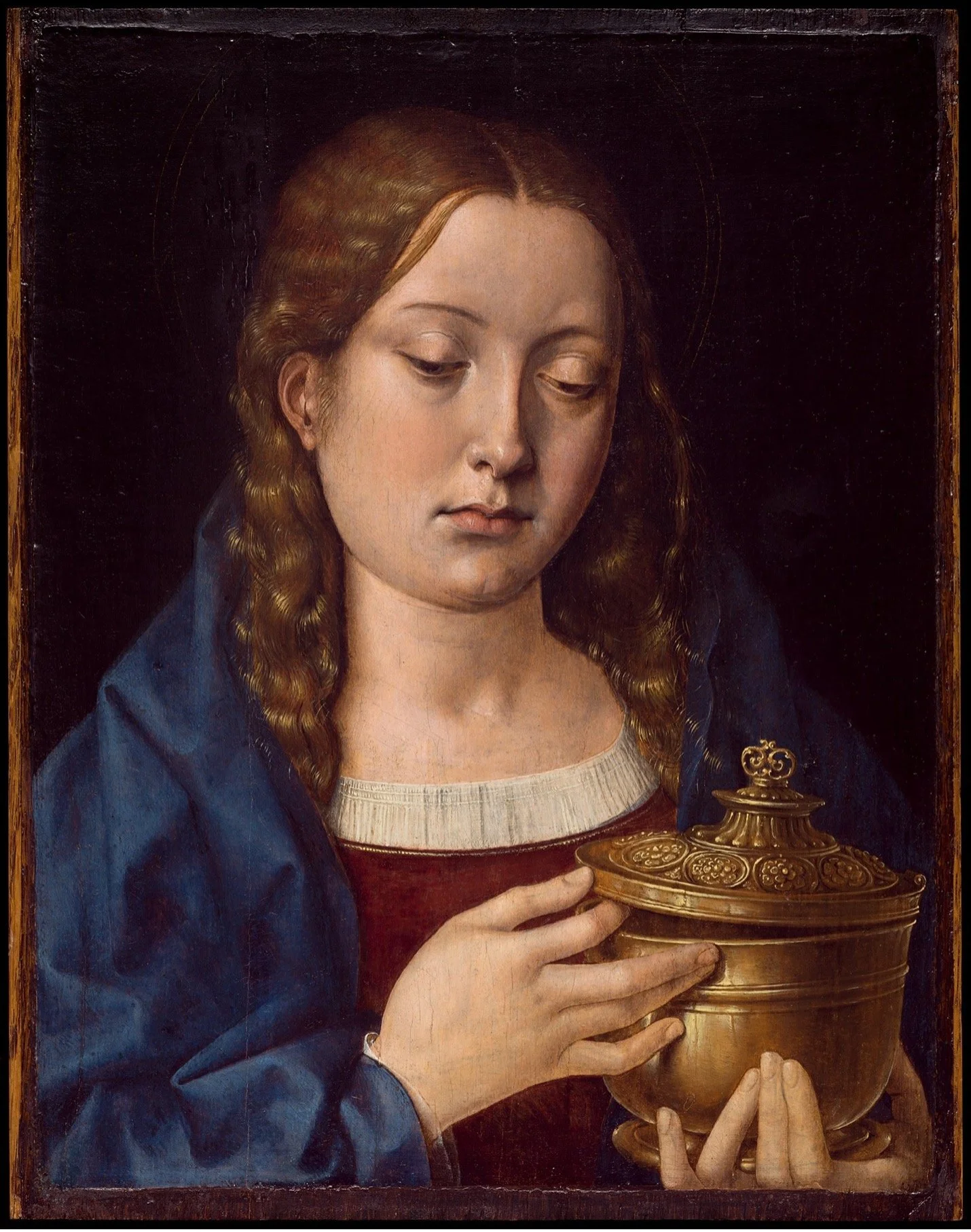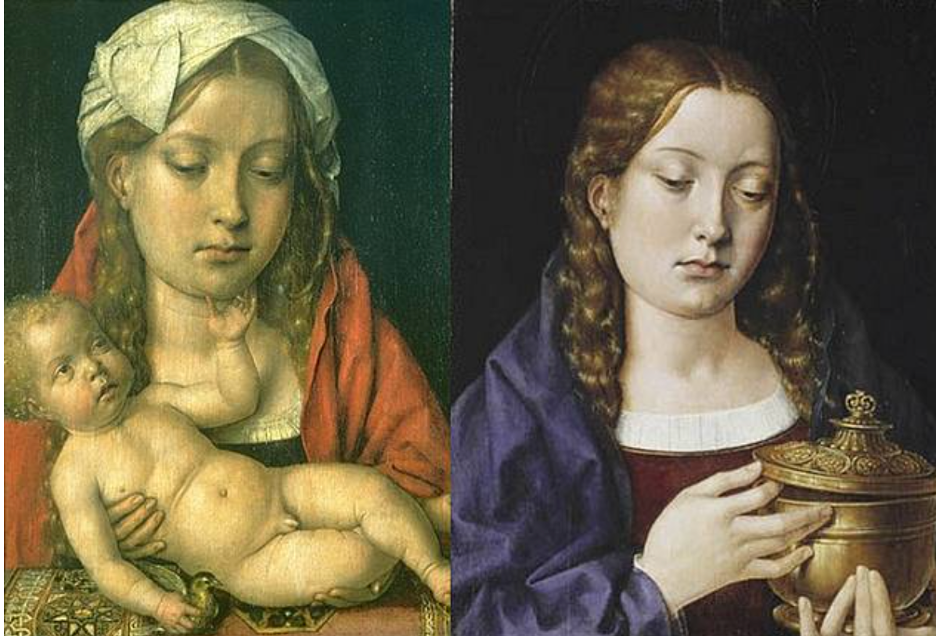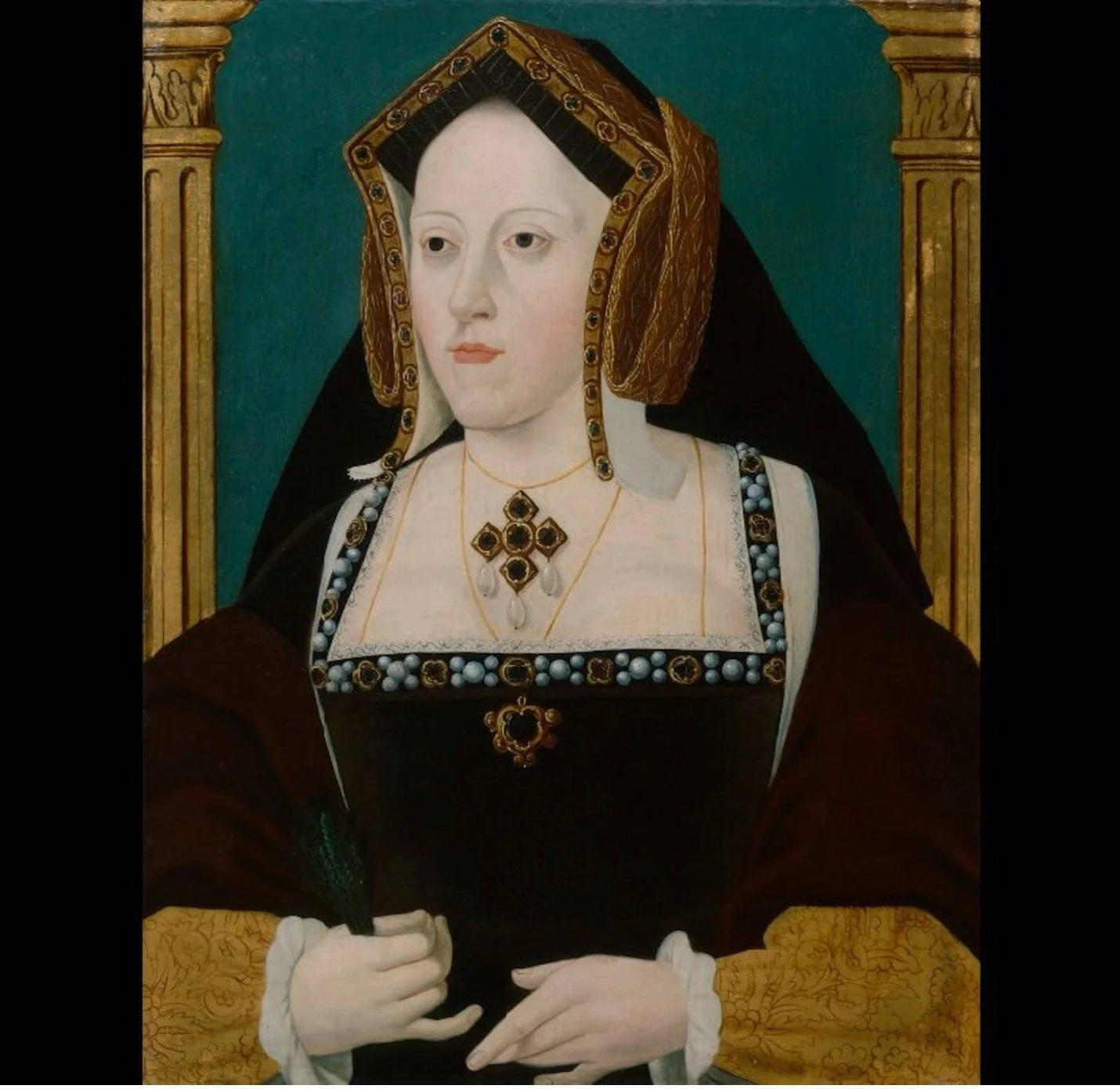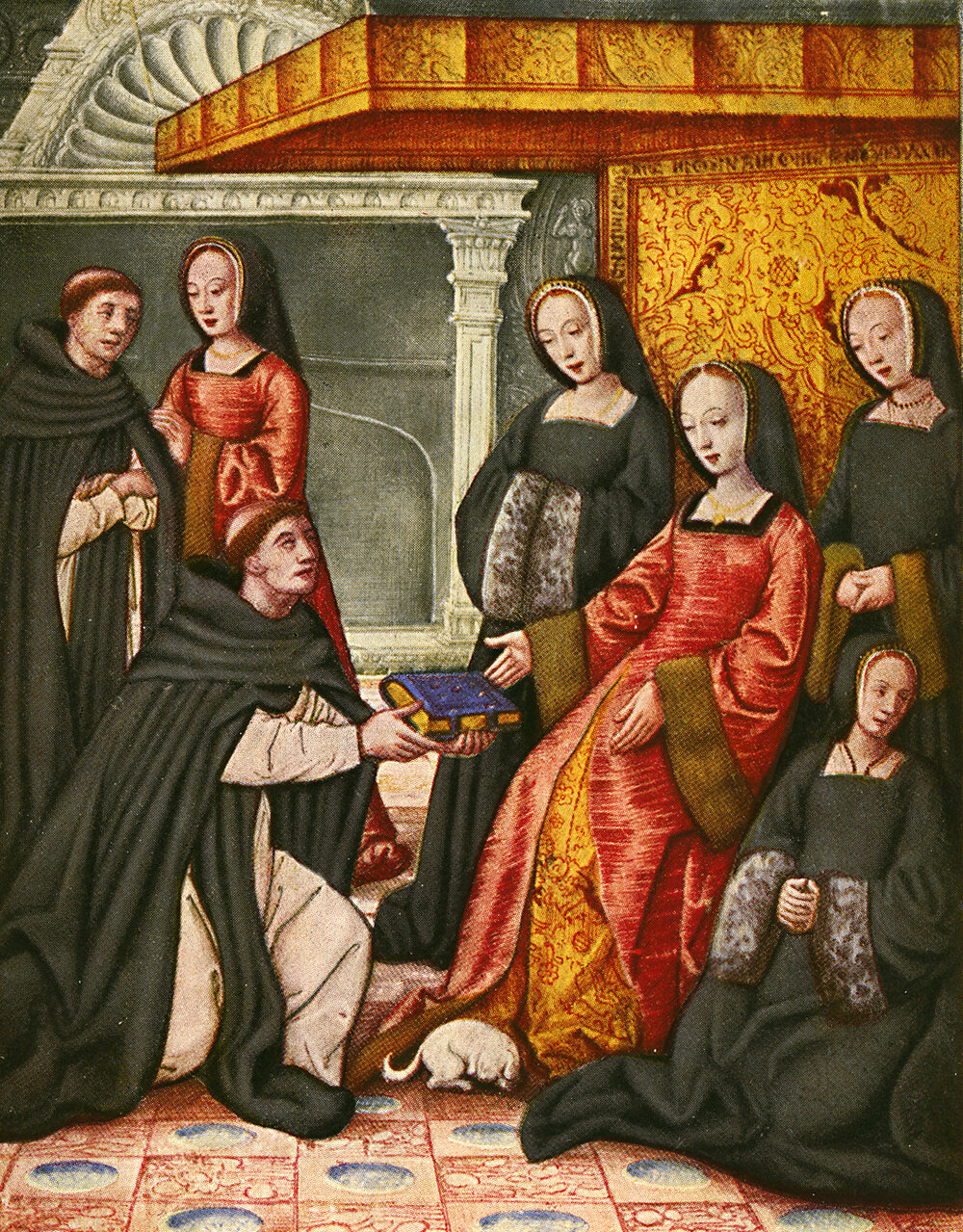Catherine of Aragon, King Henry VIII's first and longest-serving wife, faced numerous challenges throughout her life, battling for her reputation from a young age until her final days. Her unwavering fortitude is strikingly evident when examining her surviving portraits.
What can portraits of the incredible Queen of England, Catherine of Aragon, tell us about her? Kateryna Dronova explains.
Young Catherine: Glimpses from Early Portraits
The Virgin and Child, by Michael Sittow c. 1515-1518. Source: Staatliche Museen zu Berlin, Gemäldegaleri, https://recherche.smb.museum/detail/829489
Catherine of Aragon, the youngest child of the renowned Spanish monarchs Ferdinand and Isabella, was born into a world where strategic marriages were crucial for securing dynastic power. Named after her great-grandmother Katherine of Lancaster, she received a comprehensive education in governance, religion, and diplomacy, preparing her for a significant role in the interconnected European landscape.
Growing up in the royal court, Catherine witnessed pivotal historical events, such as the fall of Granada in 1492, which marked the end of the Reconquista and solidified Spain's dominance under Christian rule. Constantly on the move with her parents and sisters, the itinerant nature of the court was driven by a mix of practical considerations and the need to maintain control over a still-fragmented Spain. This upbringing instilled in Catherine a deep understanding of the complexities of ruling a kingdom and navigating the shifting political landscapes of her time.
In March 1488, a significant diplomatic effort took place between England and Spain, led by Rodrigo de Puebla, the Spanish ambassador to England. The goal was to strengthen the relationship between the two kingdoms and change the political landscape of late 15th-century Europe. The primary objective was for Henry VII's eldest son, Arthur, to marry Catherine of Aragon. Negotiations for this marriage had been ongoing, with Isabella determined to ensure a secure future for her daughter.
In 1493, when Catherine was just seven years old, it was decided that she would go to England. In 1497, Henry VII sent her a "blessed ring" as a sign of his affection.
Catherine of Aragon as the Magdalene by Michel Sittow, c. 1468 - 1525 or 1526 Source: Detroit Institute of Arts. https://dia.org/collection/catherine-aragon-magdalene-61540
Young Catherine indeed arrived in England as planned, but after marrying Arthur, she faced tragedy when he passed away just five months after their wedding in 1502. She was only 16 at the time, found herself a widow, and her future became uncertain. Despite the circumstances, she maintained that her marriage to Arthur was never consummated, a claim she upheld throughout her life.
While her portrait from that period wasn't particularly significant for her propaganda, Catherine's acute awareness of the power of visual representation in asserting her position is evident in her portraits. These images exude dignity and sorrow. Additionally, her unwavering commitment to her Catholic faith was a fundamental aspect of her identity throughout her life. All this likely motivated her decision to portray herself in biblical themes, such as Mary Magdalene, to underscore purity, holiness, and her steadfast religious convictions.
Notably, her two early portraits, attributed to the Spanish artist Miguel Sittow, are believed to depict her, aligning well with her narrative as a devout Catholic and a symbol of purity. These portraits are instrumental in presenting Catherine as a pure and virginal future bride.
The Virgin and Child, and Catherine of Aragon as the Magdalene by Michael Sittow.
This portrait reveals similarities between the depictions of Catherine as Mary Magdalene and the Virgin Mary, also by Michael Sittow, suggesting a shared model for both.
The identity of the model in these portraits remains a subject of discussion. Some suggest it could be Catherine, her sister, or their mother, Isabella I of Castile.
If its Cathrine, the portrait may serve another purpose: presenting Catherine in a more relatable light, as she is depicted in humble attire rather than regal garments. Historical depictions of esteemed queens from the thirteenth and fourteenth centuries often portray them as advocates for ordinary people, highlighting their role in interceding on behalf of the welfare of the populace. She had been preparing to be queen from a young age, so these portraits could be part of her propaganda, portraying her as a good and humble queen who understands her people.
Another portrait by Sittow, initially identified as young Catherine of Aragon, was later re-identified as Mary "Rose" Tudor, the sister of King Henry VIII.
Mary Rose Tudor by Michiel Sittow, 1514. Source: Kunsthistorisches Museum.
The association of the portrait with Catherine began in 1915 when Max Friedländer proposed this identification. Friedländer's paper focused on a painting of the Madonna and Child, noting that the sitter in the painting bore a resemblance to the young woman in the Sittow portrait. His argument was largely based on the prominent jewels in the painting: the border of gold cockleshells centered by a tiny "C" adorning the neckline of the bodice, and a heavy gold collar necklace set with jewels, pearls, and alternating enameled roses and the initial "K." Since roses were a symbol of the Tudor dynasty and cockleshells represented Santiago, the patron saint of Spain, Friedländer theorized that the woman was a Spanish princess.
However, this identification was later reconsidered. It was found that the jewelry in the portrait matched pieces given to Mary Tudor as part of the betrothal negotiations with her erstwhile suitor, the Habsburg Prince Charles ("Karolus").
At this point, none of the portraits of a young Catherine have been definitively proven to depict her. The identities of the sitters in these portraits remain subjects of debate and speculation.
Queen of England: Royal maturity
Catherine of Aragon by Lucas Horenbout (or Hornebolte), c. 1525. Source: National Portrait Gallery. https://www.npg.org.uk/collections/search/portrait/mw01143/Katherine-of-Aragon
Catherine possessed all the essential personal qualities required to be a Queen of England. While she embraced the customs of her new country, she also remained committed to furthering Spanish interests for years to come. With a foundation of strong principles, she set a high moral standard for her household. Beneath her outward appearance of meekness and submission to her husband, she harbored a resilient and tenacious character that allowed her to face the challenges that fate would later present with grace and dignity. These qualities are evident in her portraits, where she is depicted as a mature woman.
The portrait of Catherine painted by Lucas Horenbout around 1525 captures her regal stature. A miniature of her, now housed in the National Portrait Gallery, starkly contrasts with the charming young woman depicted in Miguel Sittow's 1505 portrait, revealing a significant transformation over a decade. Horenbout's portrayal presents a mature, stout woman whose countenance reflects a certain anxiety and sadness. Her once-vibrant red-gold hair now appears darker, possibly due to the pigmentation in the paint, and is styled in a bun or braid at the nape of her neck, adorned with a Juliet cap—an unconventional fashion choice in England during that period.
The inscription "Queen Catharine, his wife" indicates that this portrait was likely part of a pair, with the other depicting Henry VIII. Dated to around 1525-1527, this small work is among the earliest English portrait miniatures.
Catherine of Aragon by an unknown artist, early 18th century. Source: National Portrait Gallery, London.https://www.npg.org.uk/collections/search/use-this-image/?mkey=mw01144
The portrait by an unknown artist, located in the National Portrait Gallery in London, showcases Catherine adorned in a traditional gable hood, wearing an opulent brown velvet gown with a low square neckline. Her figure, characterized as portly, eschews claims to beauty, with a pale face conveying a slightly disdainful expression and a prominent, firm chin. The signs of aging are evident, marked by lines of sadness, while her body shows the toll of frequent childbirth, not the body of a young woman anymore. These two portraits reveal a striking evolution in Catherine's depiction.
The third portrait from her queenship period also underwent reidentification. Initially thought to depict Catherine Parr, Henry VIII's last wife, it was later identified as Catherine of Aragon.
This rare painting of Catherine of Aragon, created during her lifetime, depicts her at around 35 years of age. Portraits like this one played a crucial role in establishing Catherine's position as queen and highlighting her wealth and status, as well as that of her husband, Henry VIII. In the portrait, Catherine is depicted with her hands clasped in front of her, her face slightly turned, looking off to the side rather than directly at the viewer. This standard pose was commonly used in portraits of the time.
Katherine of Aragon by Unknown artist, c. 1520. Source: National Portrait Gallery, London.https://www.npg.org.uk/collections/search/portrait/mw194913/Katherine-of-Aragon?LinkID=mp00801&role=sit&rNo=0
The lighting on her face indicates she could be looking through a window. At the same time, her solemn facial expression matches the traditional portraits of the 1500s, which focused on social standing instead of personal traits. The expensive and fashionable clothing, along with her jewelry, demonstrates Catherine's wealth status. The costly red dye cochineal used for her clothing was accessible only to the most affluent members of society. The use of gold as a status symbol in her clothing became restricted by Henry VIII through laws that limited access to gold fabric for royalty and the elite classes of society. Rubies and pearls, which were highly valued during that period, served to demonstrate her royal status. The luxurious fabrics and jewels imported from abroad demonstrated the extensive international relationships of the country.
The recent re-identification of this portrait of Catherine of Aragon led to its pairing with a painting of Henry VIII. The artwork displays their royal positions as king and queen while showcasing the dominance of the Tudor dynasty. The artists probably created these portraits to match each other, so Catherine's posture duplicated Henry's , while demonstrating their joint power during their time as rulers.
Henry VIII,by unknown Anglo-Netherlandish artist, c.1520, and Catherine of Aragon, by unknown artist, c.1520. National Portrait Gallery, London.
Catherine experienced a period of contentment during this time because she enjoyed both her royal position and her marriage to Henry VIII. Her life was about to undergo significant changes because difficulties and disturbances were approaching.
What is with the monkey?
Catherine of Aragon with a monkey copy after Lucas Horenbout, c.1530. Source: Getty Museum. https://www.getty.edu/art/collection/object/108MGT
Several portraits depict Catherine holding a monkey. The original portrait of Catherine of Aragon, believed to be painted by Lucas Horenbout, became a significant and representative image for the Queen, with several copies made, including one in 1530. This suggests that at some point, Catherine herself embraced this particular depiction and its iconography to convey a specific message or assert her identity, especially during a period of intense personal and political upheaval.
The monkey can represent several ideas, such as subtly addressing the perceptions of femininity, loyalty, and the role of a queen in the Tudor court. Like her father-in-law, Henry VII, and several other contemporary royals, Catherine likely enjoyed having a monkey as a pet (reportedly from her native Spain).
However, this monkey serves a specific purpose in this image: it holds a Tudor rose in one hand while reaching for Catherine’s crucifix instead of the coin she offers. By the time this portrait was created, Henry VIII was already involved with Anne Boleyn. In this context, Catherine likely sought to depict herself as a wise queen and loyal wife, emphasizing her adherence to her religious convictions and her role as a steadfast and principled monarch. Her portraits convey a message of dignity and moral integrity, underscoring her commitment to her marriage and her faith, even as she faced personal and political challenges.
Could this be the message Catherine is conveying, particularly as Henry replaces her? We know that Henry VIII began the divorce process with Catherine of Aragon in 1527. Same year she promptly increased her clothing budget by 50%. Perhaps she intended to appear more attractive to the fashion-conscious king, but dressing extravagantly would also serve to assert that she, as the Queen, outranked her rival. During the years that both she and Anne remained at court, sharing the same household while Henry sought to dissolve his marriage to Catherine, the Great Wardrobe and the Royal jewels became a battleground.
Unfortunately, Catherine ultimately lost this battle. Despite her efforts to maintain her position and uphold her marriage vows, Henry pursued a divorce, which ultimately led to the annulment of their marriage in 1533. This marked a significant turning point in English history, as it led to the English Reformation and the establishment of the Church of England.
But Catherine remained resolute and refused to yield. She steadfastly rejected Henry's new church, his new wife. In her eyes, she remained the rightful Queen of England.
Catherine of Aragon died at age 50 on Friday, January 7, 1536, but despite her isolated passing, rumors of poisoning circulated widely for a long time, though they were not true.
Even after centuries, Catherine of Aragon's persona remains highly respected, and her legacy, marked by resilience, dignity, and a steadfast commitment to her beliefs, continues to be seen in her portraits, where she looks at us through the ages, whether as a young girl with curly hair or a serious queen with a strong, resolute face.
Did you find that piece interesting? If so, join us for free by clicking here.




















